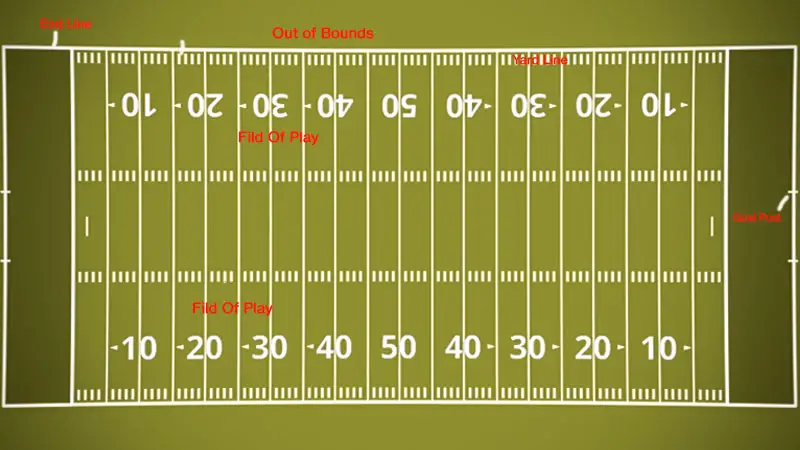Understanding the layout of an American football field can enhance your game-watching experience by helping you appreciate the strategy and skill involved. Key areas include the 50-yard line, hash marks, and goal posts, with visual aids simplifying these concepts.
The sideline, end zones, team benches, chain crew, and pylon markers are crucial for defining dimensions and scoring. Field numbers and yard lines, marked at intervals, serve as essential reference points.
Knowing these details, such as the role of the coach’s boxes and the 20-yard line for first downs, deepens your appreciation for the sport’s complexity and athlete precision, making each play more engaging.
Additionally, understanding placement nuances like the red zone’s critical scoring opportunities or the kickoff zone’s strategic importance can further enhance your insight. Each element contributes to the game’s rhythmic flow and tactical depth.
Overview of American Football Field Parts
Understanding the parts of an American football field makes the game more engaging. The field’s dimensions and markings carry specific meanings that play a crucial role in gameplay.
Field Dimensions and Layout
A standard NFL football field measures 120 yards (110 meters) long and 53 yards, 1 foot (49 meters) wide. This includes two 10-yard end zones. The field features critical markings:
- Goal Lines: Situated 10 yards in from each end, marking the start of the end zones.
- End Lines: Located at the back of each end zone, these lines mark the boundary of the field.
- Sidelines: The exterior boundaries that run the field’s length.
- Yard Lines: Horizontal lines marked every 5 yards across the field’s width help track the ball’s progress.
- Hash Marks: Small vertical dashes in line with the goalposts in the NFL, narrower at the high school and college levels, indicating where plays start.
Significance of Field Markings
Field markings guide players and officials and influence strategies and scoring:
- Goal Line: Crucial for scoring touchdowns, the ball must cross this line.
- 50-Yard Line: The central line of the field, representing a psychological landmark.
- Yard Lines: Indicate the distance to the end zones, vital for planning plays.
- Hash Marks: Determine the ball’s exact placement, affecting the angle for plays like field goals.
Each marking on the field holds significance, enhancing your understanding of game strategies and dynamics.
Key Areas of the Football Field
Understanding key areas of the football field helps you follow the game better. Each section of the field plays a crucial role in gameplay.
The End Zones
The end zones are critical scoring areas at each end of the field. They span 10 yards deep from the end line to the goal line. The goal line marks the boundary that the ball needs to cross for a touchdown, which earns the scoring team 6 points.
Besides touchdowns, end zones are where two-point conversions, safeties, and touchbacks occur. Orange pylons mark the corners, ensuring visibility. Logos or patterns may appear in the end zones but can’t interfere with mandatory field markings.
The Sidelines and End Lines
Sidelines run along the length of the field, serving as boundaries. Each sideline measures 6 feet wide and connects to the shorter end lines, forming a rectangle around the field. End lines mark the ends of the playable area.
If the ball or a player goes beyond these lines, it’s considered out of bounds. This ensures clear, manageable gameplay with defined limits for players and officials.
The Goal Line and Goal Post
The goal line, positioned 10 yards from each end line and spanning the field’s width, is crucial for scoring touchdowns and field goals. Goal posts, located behind the end lines, consist of two uprights and a horizontal crossbar.
Teams can earn extra points by kicking the ball through these uprights after a touchdown, and field goals during gameplay are worth 3 points. The placement of the goal line and posts influences many strategic decisions, enhancing the appreciation of the skill and strategy in football.
Details on Yard Lines and Hash Marks
Every inch of an American football field matters, with yard lines and hash marks playing pivotal roles in the game’s strategy.
Purpose of Yard Lines
Yard lines are crucial for tracking the ball’s progress in football. Marked every 5 yards by bold, white lines and every 10 yards by numbers, these lines help with orientation, with the 50-yard line marking midfield.
Teams aim to advance the ball across these lines to gain first downs and score. Yard lines aid players, referees, and fans by measuring distances for plays, determining first downs, and ensuring accurate spotting of the ball, thus facilitating easier officiating of the game.
Understanding Hash Marks
Hash marks, short lines parallel to the sidelines at 1-yard intervals, dictate where plays begin in football. They are wider apart in college football (70 feet 9 inches) than in the NFL (18 feet 6 inches), impacting strategic decisions, such as play-calling and player alignment.
Wider hash marks in college football provide more field space on one side, influencing tactics differently from the NFL. Hash marks are vital reference points for both offense and defense, affecting the quarterback’s vision and the running back’s path.
Understanding them offers insights into the spatial dynamics of the game.
Comparing American Football Field to Other Sports Fields
American football fields have distinct characteristics that differ significantly from fields used in other sports. Examining these differences and similarities helps you appreciate the unique aspects of each sport.
Similarities and Differences with Soccer Fields
American football fields and soccer fields share some similarities in shape, layout, and surface materials but differ in measurements and markings. Both fields are rectangular, and while soccer fields are typically grass, some football fields use artificial turf, particularly in indoor stadiums.
Dimensions
Soccer fields generally measure between 100-130 yards long and 50-100 yards wide. In contrast, an American football field is uniformly 120 yards (including end zones) in length and 53 1/3 yards wide.
Markings
Soccer fields feature penalty areas, center circles, and goal areas, crucial for specific play actions. American football fields are marked with yard lines every five yards, hash marks, and goal lines that track the ball’s movement and determine scoring plays.
Goalposts
Soccer goals are 8 yards wide and 8 feet high, whereas American football has Y-shaped goalposts situated at the back of each end zone, standing at a height of 10 feet with a crossbar width of 18 feet 6 inches.
Frequently Asked Questions
What is the layout of an American football field?
An American football field is 120 yards long and 53 1/3 yards wide. It includes a 100-yard playing field and two 10-yard end zones. Yard lines appear every 5 yards, with field numbers every 10 yards, aiding in the game’s strategy and progression tracking.
What are the key components of a football field?
Key components include end zones, sidelines, goal lines, and yard lines. Hash marks are also crucial, as they determine the ball’s placement for each play. These elements collectively enhance understanding of game tactics.
How do American football fields compare to soccer fields?
While both fields are rectangular, soccer fields vary in size from 100-130 yards long and 50-100 yards wide. In contrast, American football fields are uniformly 120 yards long and 53 1/3 yards wide, with distinct markings for yard lines, hash marks, and goal lines.
What are the differences in goalpost dimensions between soccer and American football?
Soccer goals are 8 yards wide and 8 feet high. American football goalposts are Y-shaped, standing 10 feet high with a crossbar width of 18 feet 6 inches, marking a significant difference in structure and height.
How does understanding field layout enhance the football viewing experience?
Knowing the layout, including where key elements like yard lines and end zones are located, helps viewers grasp complex strategies and game flow. It transforms watching into a more engaging and educational experience.
Conclusion
Grasping the intricacies of an American football field can significantly elevate your appreciation of the game. Recognizing key components like end zones and yard lines not only deepens your understanding but also enhances your viewing experience.
Comparing these fields to those of other sports, especially soccer, sheds light on the unique features that make American football distinct. Whether you’re a new fan or a seasoned follower, understanding the field’s layout and markings enriches your connection to the sport.
Dive into the details and enjoy the game with newfound clarity and enthusiasm. From the goalposts and hash marks to the sidelines and 50-yard line, each element plays a crucial role.
With this knowledge, you’re better equipped to follow the strategy and tactics employed by teams.








Ashley Hopkinson